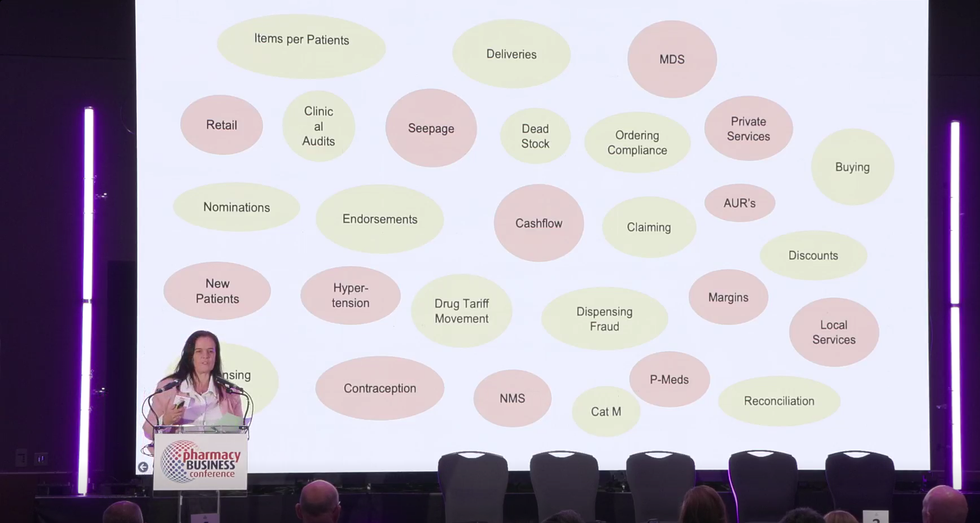Adopting new technologies is vital for moving pharmacy forward — but are you fully harnessing the data these tools generate?
“Being able to utilise, manage, and interpret the data these technologies provide can help add more value to your business,” said Adele Curran, chief operating officer at Real World Analytics (RWA) Pharmacy, while speaking at the recent Pharmacy Business Conference.
Adele highlighted the importance of connecting the dots — bringing together multiple data sources within community pharmacy — using the right tools to gain “real insights and opportunities.”
Much of the information needed for day-to-day pharmacy management is already available within Patient Medication Record (PMR) systems, which have become highly advanced.
Adele explained that daily and weekly reports from the PMR can help track productivity, manage prescriptions, identify endorsement issues, and support claims preparation.

Data can fuel business growth
“One of the biggest opportunities to grow your business is to look at what everyone else is doing,” Adele said, encouraging pharmacies to tap into publicly available NHS data to identify new opportunities and stay competitive.
Internally, pharmacies can use PMR data for service growth. Adele particularly stressed the importance of pull services, where pharmacies can control the people who come in for specific services.
“Your PMR can identify patients with hypertension, those in need of contraception, or those at risk of developing diabetes. Utilising that information can be highly effective in driving your services forward,” Adele said.
Financial insights are crucial for pharmacies. Adele stressed the need to link monthly management accounts back to operational activity to truly understand business performance.
“For example, prescribing habits — like whether GPs are prescribing branded medicines over generics — can directly impact your pharmacy’s margins,” she explained.
“Three pharmacies dispense the same number of items, but their margin points differ by 4–5%. What's causing that? Those insights are in the data between your cascade and PMR systems.”
“Embracing technologies has a cost. So, it’s important to ensure that you're getting a return on investment,” she said, noting that adjusting medicine pricing may help offset the costs of additional apps.
For investigations or strategic planning, Adele recommended reviewing surgery and competitor performance and patient KPI patterns.
Finding problems in your pharmacy
Adele shared a real-world example where connecting multiple data sources helped a pharmacy owner resolve a revenue drop at one branch.
Initially, they checked the FP34 and E-schedule, confirming that the issue was not due to changes in dispensing patterns or the drug tariff, but rather because fee items were down.
Typically, if items are down, most business owners would check patient nominations. However, in this case, nominations were steady, meaning patient numbers were stable.
By digging deeper into active nominations — a less commonly used metric — they found the real issue.
“If your active patients are 70% or less of your overall nominations, you're at higher risk as you’re getting a lot more acutes than regular patients,” Adele explained.
“More acutes means less items per patient — and less fees.”
Next, they examined the average items per patient. “If you have 4.5 or more items per patient per month, you're in a good place,” Adele said.
In this case, the pharmacy’s figure had dropped.
By further analysing public data on local surgeries, they discovered that one surgery was directing regular patients to online providers while sending acute patients to the pharmacy.
“We examined the pharmacy’s surgery mix — how many patients and what percentage of items came from each surgery — and checked if its growth was aligned with theirs.”
The amalgamation of multiple datasets — management accounts, public prescribing data, FP34, E-schedules, and PMR — helped them uncover the root cause.
“Although analysing this amount of data can feel overwhelming, finding these answers is a real game-changer,” Adele noted.
Armed with these insights, the pharmacy approached the surgery, explaining that they could offer better patient care — especially around repeat prescriptions — compared to online providers.
Within three months, the pharmacy’s item numbers stabilised, paving the way for future growth.
Adele concluded by reiterating the power of connecting multiple data sources to spot the “elephant in the room” — and the importance of using the right tools to investigate and address these challenges effectively.














